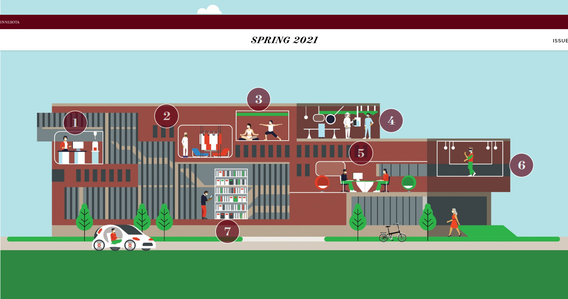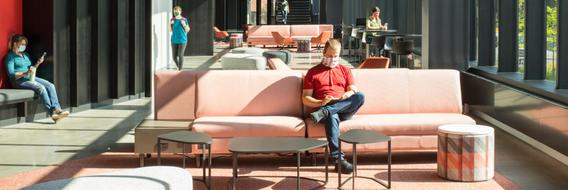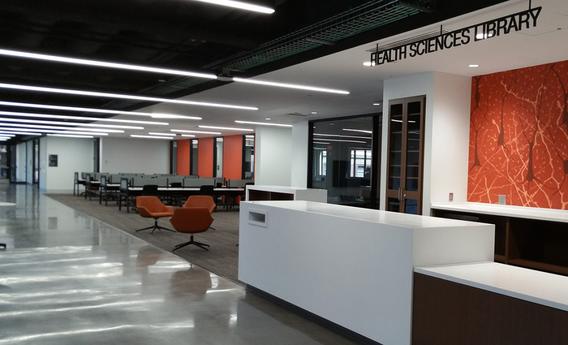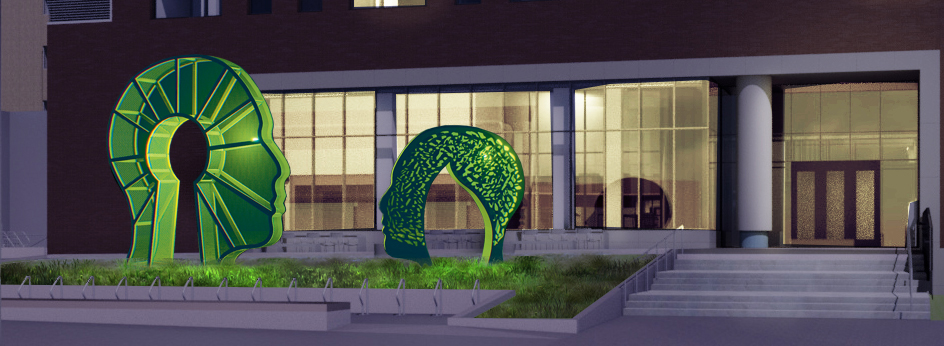Building the future of health

See inside the U’s state-of-the-art Health Sciences Education Center
With the majority of care practitioners in the state perfecting their craft at the U, it’s not a stretch to say that the health and wellness of Minnesota tomorrow starts on campus today. Story published spring 2021 by the University of Minnesota Foundation.
University of Minnesota Twin Cities shapes future of healthcare with opening of cutting-edge interprofessional health science facility
One of the study spaces in the Health Sciences Education Center at the University of Minnesota. Photo by Lara Swimmer.
The innovative, interdisciplinary education that health science students at the University of Minnesota Twin Cities have enjoyed for years continues to advance on the cutting-edge with the opening of the first-of-its-kind Health Sciences Education Center (HSEC). As the hub for all the University’s health professional schools, HSEC was designed and built to promote interprofessional education and interaction, as well as foster a culture that prioritizes student and faculty well-being.
HSEC is a unique addition to the U of M, already home to one of the most comprehensive health science centers in the nation. It’s also an asset that will benefit all Minnesotans, since the U of M teaches 70% of the state's health professionals, including physicians, nurses, dentists, pharmacists, veterinarians and public health professionals. Read more
Realizing the vision
Health Sciences Library service desk
The Health Sciences Library offers new spaces, technologies, and possibilities for education
The vision for the Health Sciences Library’s move into the Health Sciences Education Center developed around a key question, says Library Director Janice Jaguszewski: “How could the library really contribute to teaching and learning to prepare the next generation of health care providers?”
This was a collaborative vision, she says, developed with faculty, staff, and students from health sciences schools. Along with using technology as a tool to deepen student learning, the library wanted to support faculty teaching in new ways, and across disciplines.
“The Libraries are where the professions come together,” Jaguszewski says. “We see ourselves as the glue to support this new way of teaching.” Read more
This article was written by Allison Jensen and originally published by the UMN Health Sciences Library on August 19, 2020.
Health Sciences Education Center Heralds A New Beginning
Today’s new models of health care require different professions to work together using new strategies and technologies. HSEC signals a transformation in health sciences education and brings together all of the health sciences schools and affiliated programs at the University of Minnesota. Read more
Classroom Services in a New Era of Learning
Health Sciences Classroom Services ensures that classroom environments support the unique and dynamic nature of health sciences curriculum. They recently moved into the new Health Sciences Education Center (HSEC) and prepared classrooms for when students return to campus. “Last week, I spent four days in HSEC walking all the rooms with the installers and designers to tie down the final tech. details. We pushed every button and flipped every switch. After four years of thinking of these spaces abstractly, getting to play in the rooms and seeing systems respond made everything much more real,” said V. Paul V., services coordinator for Health Sciences Classroom Services.
HSEC Plays Host in Pandemic Response
The Health Sciences Education Center (HSEC) is playing host to a number of contact tracers from the School of Public Health (SPH) and Medical School for the next several weeks.
A new sculpture by Artist Barbara Grygutis will be a highly visible addition to the University’s new Health Sciences Education Center
With its focus on active, team-based learning in small-group environments, the Health Sciences Education Center (HSEC) has been designed to transform health education in Minnesota. The new facility will offer places to connect, collaborate and communicate across disciplines.
In June, the spirit of the new facility will be brought to life through art. Read more
Helping radiology students see 2D medical images in 3D anatomy
"This project started as a quality improvement project. Early in your training, particularly in medical school and early in residency, it can be difficult to understand spatial relationships of medical imaging when you are viewing three dimensional anatomy on a two dimensional screen," said Mickey Hafertepe.
Virtual reality helps physical therapy students see new answers
Patients experiencing “phantom limb” pain in nerve endings after an amputation can use such technology to virtually view the missing limb and exercise it, measurably easing their pain.
‘I now know that I am on the right career path’
Kaylee Morlan was first introduced to the Wangensteen Historical Library of Biology and Medicine while taking a freshman seminar course co-taught by the library's Assistant Curator, Emily Beck. With her sights set on a career in museum studies, Morlan was able to get a job at the library and gain hands on experience in her chosen field.
3D-printed gene segment models aid in active learning
Co-instructors Michelle Henry-Stanley and Donna Spannaus-Martin wanted to teach about genetic recombination using a tactile, hands-on educational tool. They connected with our Makerspace staff to produce low-cost sets of 3D printed immunoglobulin gene segments to support new ways of teaching and learning and meet their active learning goals.
‘Everyone at the library loves being here’
When she was in middle school, Kaitlyn Minarsich’s older brother took her to an exhibit showcasing items from the Wangensteen Historical Library of Biology and Medicine where he worked as a UMN undergraduate student. Minarsich is following the family tradition, working at the library to convert a 2013 physical exhibit on Downton Abbey into an updated, online interactive exhibit — just in time for the release of the Downton Abbey movie this fall. Minarsch shared some of her experiences from working at WHL. Here’s what she had to say.
‘Librarians can not only help you find resources but can also help you shape and refine your project’
Louisa Botten, a first year undergraduate at the University of Minnesota, recently completed an internship at the Wangensteen Historical Library. Read how Botten combined this historical text with modern technology to create an award-wining online exhibit.
Using 3D technology to reach individual goals in rehab therapy
You may know Leah Grinvalsky as a Physical Therapy student at the U of MN, but we also know her as a friend to Katrina Simons. This friendship played an important role in Grinvalsky’s first visit to the Bio-Medical Library Makerspace, where she explored solutions to help Simons participate in gaming. Here's what Grinvalsky had to say about her experience creating 3D printed adaptive technology.




